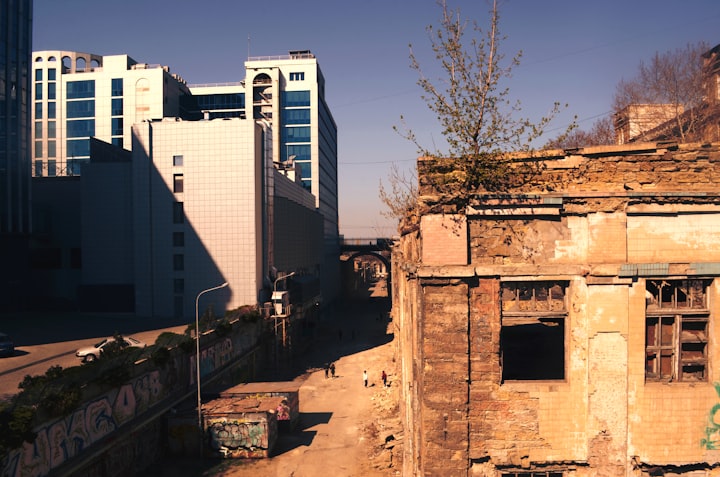Selling a House in Poor Condition
You do have options

Sometimes we have a property that we just need to get off our hands. Often, this is one that may not be in the most ideal and pristine condition.
Many sellers think that they need to fix the house up first, before they sell, or assume that they’ll have to accept a rock-bottom offer if they want to sell the home as-is, but this isn’t always the case. If you have something to sell, there will always be someone ready to buy. Your best option is to ensure that you have a good understanding of the property’s condition, and a realistic idea of how much you can expect the property to sell for, both before repairs, and after. Being clear on your options will also give you a better idea of whether you should sell the property as-is, or if it would be worth investing some time and money to bring it into good condition first.
In this guide, we’ll uncover the difference between uninhabitable, poor condition, and deferred maintenance homes –and see what options you have available to you with regards to selling or even upgrading the property prior to selling.
Read on to see how you can get your home ready to sell and command a good price, no matter what condition it’s in.
The Wide-Spectrum of “Poor Condition”
First up: poor condition –what does it mean?
It’s important to note that the term poor condition can be used to refer to properties in a wide range of different conditions ranging from homes that are a bit neglected with some deferred maintenance to ones that are completely uninhabitable.
When it comes to selling these properties, your options will vary, depending upon where your home is located on this scale.
Let’s take a look at the different types of poor condition homes now:
Uninhabitable Homes
First up, an uninhabitable home is one that could be deemed as condemned by the health department, this label is not one that you can easily adjust or remove. It’s important that we clarify what uninhabitable conditions would consist of, as these are major problems that need to be transparently noted between seller and buyers.
Properties can receive this label if they have poor inspection reports due to:
- Fire
- Flooding
- Drug-related activity
Larger common issues: This can include but is not limited to:
- Severe structural problems
- Non-functioning systems such as electricity and plumbing
- Inadequate heating or cooling systems
- Serious or extensive roof damage
- Black mold
- Lead-based paint or flooring
- Asbestos
- Termite infestations or termite damage that have not been repaired
- Serious foundation issues
- Serious chimney damage
Poor Condition Homes
Next up, we have the mid-tier condition: homes that are in overall poor condition. This usually refers to a home that still meets the basic requirements of habitability. The problems and concerns related to poor condition homes can either be fixed or ignored, and the home would still be livable.
Poor condition properties, however, can create problems when it comes to selling. One example of this is a house that has been previously inhabited by someone who hoarded; it doesn’t make for the cleanest and most attractive property for potential buyers, but it’s still a property that could be put up on the market if the price was right.
Properties can be considered to be in poor condition if they have one or more of the following problems:
- Minor electrical issues
- Serious plumbing problems
- Roof damage
- Rotting wood
- Foundation cracks and concerns
- Failing or unreliable heating and cooling systems
- Damaged and outdated kitchen or bathroom
- Damaged flooring
- Damaged and/or non-functional faucets and/or light fixtures
These are all problems that can be rectified at the seller’s choice or buyer’s request but in most cases, it would cost a hefty fee to do so.
Deferred Maintenance Homes
These are houses that have minor issues that don’t make a home unlivable. It likely relates to the fact that the home is older and requires upgrades or repairs, but has no prominent health or safety concerns that are worth noting.
Properties that have deferred maintenance typically have one or more of the following issues:
- Dirty or cluttered interiors: Consider a hoarding situation where there were no health concerns, but the prior owner was unable to remove the items from the property
- Dated kitchens or bathrooms
- Dirty or stained flooring and floor coverings
- Dirty walls, peeling paint, or dated wallpaper
- Outdated finishes on faucets or light fixtures
- Poorly maintained landscape: Plants could be dead, overgrown, or untended
- Weathered exterior: This could include peeling paint or minor wood rot
Selling Options for Uninhabitable and Poor Condition Properties
Just because the property you’re looking to sell isn’t in the most pristine condition, or has even been deemed uninhabitable by health authorities, doesn’t mean you’re out of options. You have a few potential avenues of action that you can take. The best option will depend on your goals, and your time, availability, and budget.
Here’s a look at the different options for selling this type of property:
Selling Your Property “As Is”
If you are short on time or resources to get the property into good condition, then selling your home in "As-Is” condition may be a viable option. If you’re selling something, someone will want to buy it, and for them, this condition is perfectly acceptable. This is usually the best option if a house has been deemed uninhabitable, or is in exceptionally poor condition, where it would require significant time and resources to bring it into good condition, and where the cost of doing so is unlikely to make a significant difference in the amount of profit that you’d generate.
For example, if a house is worth $200,000, and is in poor condition –and would require $50,000 to bring it into habitable condition, but the appraisal value after repairs is only expected to be at $220,000, then this additional work is most likely not worth doing.
Selling a house in poor condition “as is” requires a few essential steps from you, the seller:
Disclose All Information: Sellers must disclose any and all problems with the property. This includes the history of the property and the material facts that might deem the condition of the home to be “poor.” If you are unable to make a transparent list of what the buyer needs to know, that’s where step two comes into play.
Do a Pre-Listing Inspection: This will help you get a professional overview of the true property condition in order to disclose this information to potential buyers. A pre-listing inspection is also a great way to get an overview of the property’s true condition.
Get a list of items required to sell the property
Price out those repairs
Subtract the results from actual market value to determine your as-is listing price
If the price is significantly below market value we often see the sales price get bid up by those looking for a deal. This is okay, as long as you have disclosed it.
If you decide to list the price of the house significantly below market value, while simultaneously disclosing all the necessary information about the property and the results of the pre-listing inspection, your sale price may get bid up by those who are looking for a deal. This is perfectly acceptable if you’ve taken the steps necessary to disclose all information about the property.
Remember to Protect Yourself: The results of the inspection are meant to be transparently disclosed. This means all negative aspects of the property must be reported to the potential buyer. This is good practice in all real estate selling since many real estate-related court cases are about lack of disclosure. Protect yourself by anticipating all questions about the property and being ready to share all of the less attractive information about it, as well.
Selling With Dollar Credit
If selling “as is” doesn’t appeal to you, another option is to sell your investment property with dollar credit. This is more complicated than selling “as is” because it means that you will sell the home at market value but agree to the terms with the buyer that you will offer credit for all upgrade items or repair.
If you are considering selling with this option, it’s important that you get an inspector’s professional opinion on the maximum budget available for specific repairs, so you are not crediting beyond your budget. Another downside to this option is that you may be working alongside the buyer for much more time than you anticipated. This is not an in-and-out deal, as it requires the time allotted for repairs.
Selling Your Property to a Wholesaler
You always have the option of contacting a property wholesaler to take the home off of your hands. It’s still a good idea to go through the research and inspection steps to ensure you aren’t just giving the property away and losing a potentially good opportunity to make more money on your home.
Selling Your Property to an iBuyer
Selling your property to an iBuyer is a similar option as a wholesaler, but it’s done online. An iBuyer, or institutional buyer, is a company that uses technology to make an offer on the property –instantly. This approach to selling can help to expedite the sales process, making it a fast and easy alternative to a standard home sale. Websites such as Zillow and Opendoor allow you to quickly list your home.
Renovating and Selling Your Property
Finally, we have renovating and selling the property. This can be costly, but it can a good option in some cases. It’s an avenue that should be considered if the numbers make sense; that is, if you’ve factored in the costs along with the estimated after-repairs value.
Like any real estate investment, if you’re considering fixing and then selling your home, you need to look at the true market value of your home minus your cost of acquisition, plus the cost of repairs (as determined by professional contractors). This should guide your decision as to whether this is the right choice for you.
It often makes more sense to consider the cost of repairs and to try to bring the condition up to an acceptable standard, then selling it on the open market as your return on investment could be quite high. In many cases, this may only mean completing minor repairs, cleaning, or even proper staging.
This approach will also allow you to anticipate what buyers may find when they’re doing inspections, and to also indicate to potential buyers that you have put in the cost and the effort to repair the negative conditions of the house and have priced the property according to those repairs. If there are major repairs that cannot be budgeted, repair what you can, disclose what cannot be fixed, and discount the home accordingly.
Other Things to Consider When Selling a House in Poor Condition
As with selling any home, regardless of its condition, sometimes there are bumps in the road that can get in the way of a smooth sale. Here are a few things you’ll want to keep in mind when selling a home that’s in poor condition:
- Cash-only buyers: Potential buyers may face an inability to obtain financing, whether FHA, VA, or even conventional financing. This is because the FHA, VA, and even conventional lenders have strict guidelines about the condition of the property that they’re financing and in most cases, poor condition properties won’t qualify. This means that when selling a home in poor condition, you may be looking largely at cash-only buyers. Cash buyers are usually investors who are looking for a deal, which means you may have to contend with a number of offers that are below market value.
- Using a Home Equity Line of Credit to make repairs before selling: If you don’t have the money to allot to this extensive project, you can consider a HELOC or Home Equity Line of Credit. If there is existing equity in the property, you can take out a HELOC in order to pay for repairs.
Just because you’re selling a house in poor condition, doesn’t mean you’re out of options. Instead, you simply need to consider your circumstances and how much time, effort, and money you have available to invest in the property prior to selling. Knowing what avenue to choose when selling your home depends on your resources and the condition of the property itself.
In almost every case, it’s a good idea to get a professional inspection, this serves to make you aware of the true property condition. Using that information, you will be able to run the numbers and better understand which options will lead to the most profitable results. Poor condition doesn’t have to mean that you’ll see no profit; as long as you’ve done your research, run the numbers, and found an option that will work best for you.
About the Creator
springshomes
Real Estate Broker in Colorado Springs, Colorado. Writes about issues pertaining to home buyers, home sellers.






Comments
There are no comments for this story
Be the first to respond and start the conversation.